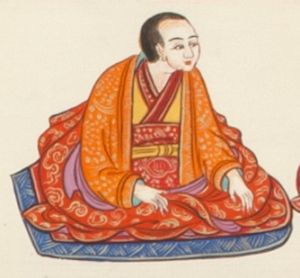The Life and Works of Tsen Khawoche: Founder of ‘the Meditative Tradition’ and Tibetan ‘Empty-of-Other’
Inspired by the new English translation of a biography of 11th century Tibetan master, Tsen Khawoche (btsan kha bo che, b. 1021), by Alexander Gardner, published online by Treasury of Lives, I decided to write a short post about this great Tibetan scholar, master and translator who was an extremely important and influential figure for the Karma Kagyu and Jonang Shentong traditions. As it states in the biography:
“Tsen, who studied at Toling monastery and went to Kashmir seeking further guidance, understood buddha-nature to be the natural luminosity of mind. Unlike the mainstream Madhyamaka asserted by Ngok, Tsen held that all phenomena are empty save for buddha-nature, which is unconditioned and which possesses innate qualities.
This position became known as the “Tsen tradition” (btsan lugs) or the “meditative tradition” (sgom lugs) of buddha-nature exegesis, in contrast to the “analytic tradition” (thos bsam gyi lugs) or “epistemological tradition” (mtshan nyi kyi lugs) based on Ngok’s famous commentary to the Ratnagotravibhāga. Tsen is
considered by Tibetan historians to have been a disseminator of Yogācāra doctrine, and likely accepted all Five Books of Maitreya as definitive. Ngok, by contrast, considered the Ratnagotravibhāga to be the sole
definitive teaching of the Five Books of Maitreya; he classified the other four as Yogācāra and therefore provisional. Tsen’s work thus inspired the “other-emptiness” (gzhan stong) writing of Jonang masters, Dolpopa Sherab Gyeltsen (dol po pa shes rab rgyal mtshan, 1292-1361) and Tāranātha (1575-1634).“
I first came across the name Tsen Khawoche when researching my translation and study of Taranatha’s Commentary on the Heart Sutra. In the section of this book, on the origination of the Shentong (gzhan stong) doctrine, I wrote this:
Jonang Kunga Drolchog (Kun-dga’-grol-mchog)’s citation of the statement made by the Tibetan scholar and translator Tsen Khawoche (bTsan-kha-bo-che), regarding his teacher Sajjana’s view of the three Turnings, was seen as sufficient to refute any criticism made by Tibetan critics who claimed that the Empty-of-Other tradition was completely unknown in India prior to Dol-po-pa:[1]
The Jo-nang-pas, for one, claim that their gzhan stong position had earlier been staked out in India, for example by the Kashmiri Paṇḍita Sajjana (11th cent.) who adhered to a distinction between the real and imputed. In his “History of the Collection of One Hundred Instructions,” Jonang Kunga Drolchog (1507–1566) reports that Tsen Khawoche said about Sajjana:
Sajjana, the paṇḍita from Kashmir, made the very significant statement that the victorious one turned the dharmachakra three times. The First dharmachakra concerned the [[Four Noble] Truths]], the Middle one the lack of defining characteristics, and the Final one careful distinctions. The First two of them did not
distinguish between the real and the imputed. During the ultimate ascertainment of the Final one, he taught by distinguishing between the Middle and the extremes (Skt. Madhyāntavibhāga) and by distinguishing between phenomena and their true nature (Skt. Dharmadharmatāvibhāga).
To sum up, the synthesis of Yogācāra and Tathāgatagarbha in the Maitreya works reflects a serious alternative to the Madhyamaka hermeneutics of Candrakīrti, and can thus be considered a realistic Indian precedent of gzhan stong.
This passage is also quoted by Brunnhölzl (2014: 143) along with the additional comments by bTsan-kha-bo-che:
That this appears [in] an old notebook of bTsan-kha -bo-che himself, which bears the name Lotus Hook, shows that one should reject the later claim that the conventional term gzhan stong was completely unknown in India and [only] appeared later in Tibet with the Omniscient Dol-po-pa.
It is interesting to note that as Tsen did not know Sanskrit, he engaged the services of another of [[[Sajjana’s]] disciples, Zu Gawai Dorje (gzu dga’ ba’i rdo rje), to translate the the Ratnagotravibhāga. The biography goes on to say that:
Zu himself wrote a commentary on the Ratnagotravibhāga that served as a main source for the Karma Kagyu compositions on the topic by the Third Karmapa, Rangjung Dorje (karma pa 03 rang byung rdo rje, 1284-1339), Karma Trinle (karma ‘phrin las, 1456-1539), and Go Lotsāwa Zhonnu Pel (‘gos lo tsA ba gzhon nu dpal, 1392-1481)…..
There is a short section in the One Hundred Instructions of the Jonang on Tsen Khawoche’s teachings, titled Instructions on the View of Other-Emptiness (gzhan stong gi lta khrid). Kunga Drolchok (kun dga’ grol mchog, 1507-1565), the compiler, was the twenty-fourth holder of the monastic seat of Jonang Monastery.
May the Shentong lineage and teachings flourish and may all beings attain the awakened state of Buddha Nature!
Written and compiled by Adele Tomlin, 20th November 2018.
[1] From Mathes 2012: 189–198 and see also Stearns 1999: 42–45.
Bibliography
Karl Brunnholzl, When the Clouds Part: The Uttaratantra and its Meditative Tradition as a Bridge between Sūtra and Tantra. Boston and London: Snow Lion, 2014.
Klaus-Dieter Mathes, “The gZhan stong Model of Reality – Some More Material on its Origin, Transmission and Interpretation.” Journal of the International Association of Buddhist Studies, 34.1–2 (2012) 187–223.
Cyrus Stearns, The Buddha from Dolpo: A Study of the Life and Thought of the Tibetan Master Dolpopa Sherab Gyaltsen. Delhi: Motilal Banarsidass, 1999.
Alexander Gardner, “Tsen Khawoche,” Treasury of Lives, November 19, 2018, http://treasuryoflives.org/biographies/view/Tsen-Khawoche/7113.
Source
[[1]]
